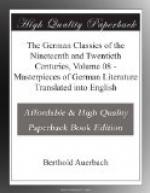Our South-German peasants still live completely in the Rococo as regards artistic taste. They have forgotten the Middle Ages and have not yet found modern art. To the peasant of the Black Forest, the splendid, baroque, dome-shaped church of St. Blasien is a much greater marvel of native art than the Freiburg cathedral. Gaudy, exaggeratedly fantastic Rococo saints are generally considered by Catholic country people very much more edifying than a picture in the severe style of the Middle Ages or of the modern school. In the ornamentation of utensils and houses of our peasants the Rococo style has quite naively been carried along into our own times, and whoever nowadays wishes to have genuine Rococo chairs in his parlor not infrequently searches through the peasants’ houses. The pleasure which the peasant takes in the Rococo, which has bravely survived so many changes in taste, is easily explained. The peasant himself is an original, rather, ’tis true, as a species than individually, and the brilliant, fantastic, affected, violent quality of the Rococo appealed to his rough, sturdy child’s nature, just like large capital letters. On the other hand he never sympathized with the genuine Pigtail. The scant, niggardly dress-coat of this period was never adopted as the prevailing costume of the people, any more than the fashion of wearing the hair in a real pigtail, and the bare facades of the academic Pigtail architecture never became epoch-making in popular, architecture. The peasant only appropriated to himself the Rococo out of the Pigtail of the last century.
We pedantic city people, on the contrary, in the outer construction of our houses, in their joiner-like, barrack architecture with the monotonous rows of windows, have all this time remained prisoners of the Pigtail; but in the gaudy, whimsical decoration of our rooms, on the other hand, we have reached the Rococo once more, and only very recently have we begun to improve by going back to the powerful individualism of the Renaissance—as, for instance, in many of the new streets in Munich. There is, however, nothing adventitious about this, for, in general, a more personal, original life is flourishing in our bourgeoisie than there was twenty years ago.
In the Rococo period there was an endless amount of portrait painting, and this partiality to having one’s picture done in oils, pastel, engraving, in silhouette and in miniature medallion, maintained itself throughout the entire Pigtail period. It was conformable to the spirit of the times and to one’s rank to look upon one’s own features as something not to be despised, and not a soul suspected that there was any personal vanity in it.




